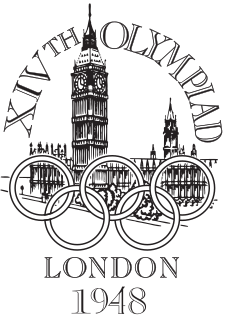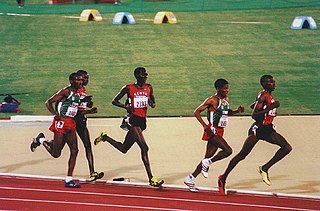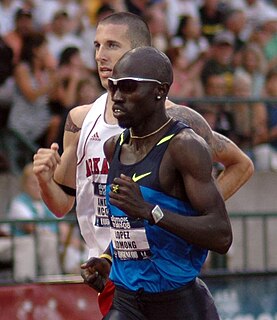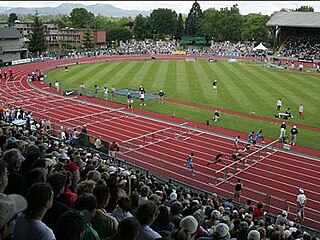
The 1948 Summer Olympics were an international multi-sport event held from 29 July to 14 August 1948 in London, United Kingdom. Following a twelve-year hiatus caused by the outbreak of World War II, these were the first Summer Olympics held since the 1936 Games in Berlin. The 1940 Olympic Games had been scheduled for Tokyo and then for Helsinki, while the 1944 Olympic Games had been provisionally planned for London. This was the second time London had hosted the Olympic Games, having previously hosted them in 1908, forty years earlier. The Olympics would again return to London 64 years later in 2012, making London the first city to have hosted the games three times, and the only such city until Paris and Los Angeles host their third games in 2024 and 2028, respectively. The 1948 Olympic Games were also the first of two summer Games held under the IOC presidency of Sigfrid Edström.

Track and field is a sport that includes athletic contests based on running, jumping, and throwing skills. The name is derived from where the sport takes place, a running track and a grass field for the throwing and some of the jumping events. Track and field is categorized under the umbrella sport of athletics, which also includes road running, cross country running, and racewalking.

The 200 metres, or 200-metre dash, is a sprint running event. On an outdoor race 400 m track, the race begins on the curve and ends on the home straight, so a combination of techniques are needed to successfully run the race. A slightly shorter race, called the stadion and run on a straight track, was the first recorded event at the ancient Olympic Games. The 200 m places more emphasis on speed endurance than shorter sprint distances as athletes predominantly rely on anaerobic energy system during the 200 m sprint. Similarly to other sprint distances, the 200 m begins from the starting blocks. When the sprinters adopt the 'set' position in the blocks they are able to adopt a more efficient starting posture and isometrically preload their muscles. This enables them to stride forwards more powerfully when the race begins and start faster.

The 10,000 metres or the 10,000-metre run is a common long-distance track running event. The event is part of the athletics programme at the Olympic Games and the World Athletics Championships, and is common at championship level events. The race consists of 25 laps around an Olympic-sized track. It is less commonly held at track and field meetings, due to its duration. The 10,000-metre track race is usually distinguished from its road running counterpart, the 10K run, by its reference to the distance in metres rather than kilometres.

The USA Track & Field Outdoor Championships is an annual track and field competition organized by USA Track & Field, which serves as the American national championships for the sport. Since the year 1992, in the years which feature a Summer Olympics, World Athletics Championships or an IAAF Continental Cup, the championships serve as a way of selecting the best athletes for those competitions.

The United States Olympic trials for the sport of track and field is the quadrennial meet to select the United States representatives at the Olympic Games. Since 1992, the meet has also served as the year's USA Outdoor Track and Field Championships. Because of the depth of competition in some events, this has been considered by many to be the best track meet in the world. The event is regularly shown on domestic U.S. Television and covered by a thousand members of the worldwide media. As with all Olympic sports, the meet is conducted by the national governing body for the sport, currently USA Track & Field (USATF), which was previously named The Athletics Congress (TAC) until 1992. Previous to the formation of TAC in 1979, the national governing body for most sports was the Amateur Athletic Union (AAU).

The 2004 United States Olympic trials for track and field were held at Hornet Stadium in Sacramento, California. Organised by USA Track and Field, the ten-day competition lasted from July 9 until July 18 and served as the national championships in track and field for the United States.

The men's 110 metres hurdles event at the 2016 Summer Olympics took place between 15–16 August at the Olympic Stadium. Forty athletes from 27 nations competed. The event was won by Omar McLeod of Jamaica, the nation's first gold medal and second medal overall in the event. Orlando Ortega's silver was Spain's first medal in the men's high hurdles, while Dimitri Bascou's bronze was France's first medal in the event since 1976.
The 1932 United States Olympic trials for track and field were held on July 15 and July 16, 1932 and decided the United States team for the 1932 Summer Olympics in Los Angeles. The trials for men and women were held separately; men competed in Stanford Stadium in Stanford, California, while women competed in Dyche Stadium in Evanston, Illinois. Both meetings also served as the annual United States outdoor track and field championships. For the first time, only the top three athletes in each event qualified for the Olympics; until 1928, every nation had been allowed four entrants per event.
The 1928 United States Olympic trials for track and field were held between July 3 and July 7, 1928 and decided the United States team for the 1928 Summer Olympics in Amsterdam. For the first time, women's track and field was part of the Olympic program. The trials for men and women were held separately; men competed at Harvard Stadium in Cambridge, Massachusetts on July 6 and July 7, while women competed at City Field in Newark, New Jersey on July 4. Three of the men's events were contested in Philadelphia, Pennsylvania between July 3 and July 5.

Anne Marie Vrana O'Brien was an American sprinter. She represented the United States at the 1928 Summer Olympics in the 100 meters and at the 1936 Summer Olympics in the 80-meter hurdles. In 1932 she equaled the 80-meter hurdles world record, but fell at the Olympic Trials and missed the Olympics.
The 1984 United States Olympic trials for track and field were held at Los Angeles Memorial Coliseum in Los Angeles, California, the same venue as would host the 1984 Olympics a month and a half later. Organised by The Athletics Congress (TAC), the nine-day competition lasted from June 16 until June 24. The national championships in track and field for the United States was a separate event that year, held a week earlier in San Jose, California. The women's marathon Olympic trials were held on May 12 in Olympia, Washington. The men's marathon trials were in Buffalo, New York on May 26.
The 1988 United States Olympic trials for track and field were held at IU Michael A. Carroll Track & Soccer Stadium in Indianapolis, Indiana. This is the only time this venue has been used for the Olympic trials. With the 2013 installation of Field Turf, it is unlikely to host the event again. Organised by The Athletics Congress (TAC), the nine-day competition lasted from July 15–23. The national championships in track and field for the United States was a separate event that year, held a week earlier in Tampa, Florida, the last time the Olympic trials were not also the National Championships. The women's Marathon Olympic trials were held on May 1 in Pittsburgh, Pennsylvania. The men's Marathon trials were in Jersey City, New Jersey on April 24. That same day, the 50K Racewalk trials were held adjacent to the stadium.

The men's 1972 United States Olympic trials for track and field were held from June 29 to July 9 at Hayward Field in Eugene, Oregon, organized by the AAU. These were the first trials with no preliminary events; athletes merely had to meet the qualification standard in their event. This was also the last time the women's Olympic trials were held separately, and the ten-day competition in Eugene was held over eleven days.

The 2016 United States Olympic trials for track and field were held at Hayward Field in Eugene, Oregon. Organized by USA Track and Field, the ten-day competition lasted from July 1 to July 10 and served as the national championships in track and field for the United States.
The men's 1968 United States Olympic trials for track and field were a two-tiered event. Athletes first met for semi-final Olympic trials in Los Angeles, from June 29–30. The final trials were held following a training camp at a specially constructed track at Echo Summit, California, between September 6–16. This was called the most bizarre location for an Olympic trials ever, selected to mimic the nearly identical high altitude location for the Olympics in Mexico City in October.
The men's 1964 United States Olympic trials for track and field were a two-tiered event. Athletes first met for semi-final Olympic trials in Randalls Island, New York, from July 3-4. The final trials were held at the Los Angeles Memorial Coliseum, Los Angeles, California, between September 12 and 13. The Colisseum had hosted the Olympics 32 years earlier and would come to host the Olympics a second time 20 years later. The races at Los Angeles were only the finals, selected from the top runners in the semi-final Olympic trials in New York. The 20 kilometer walk trials were held in Pittsburgh, Pennsylvania, on July 5, and the 50 kilometer walk trials were held on September 5 in Seattle, Washington. Two marathon trials were held, the AAU National Championships in Yonkers, New York, on May 24 selected one entrant, while the Western Hemisphere Marathon in Culver City, California, on July 26 selected two. American resident, but Taiwanese citizen C. K. Yang was allowed to participate in the decathlon, but his dominant performance did not displace the American athletes in the trials. The process was organized by the AAU.

The men's 1960 United States Olympic trials for track and field for men were held at the Stanford Stadium at Stanford University in California, between July 1 and 2. The 20 kilometer walk trials were held in Baltimore, Maryland, on July 17, and the 50 kilometer walk trials were held on July 3 in Pittsburgh, Pennsylvania. Two marathon trials were held between two races, the AAU National Championships in Yonkers, New York, on May 22 and the Boston Marathon in Boston, Massachusetts, on April 19. As it turned out, the three selectees were the top 3 at Yonkers, but that is because Gordon McKenzie was also the first American finisher at Boston.

The men's 1956 United States Olympic trials for track and field for men were held at the Los Angeles Memorial Coliseum in Los Angeles, California, on June 28 and 29. The 20 kilometer walk trials were held in Pittsburgh, Pennsylvania, on August 26, and the 50 kilometer walk trials were held on September 16 in Baltimore, Maryland. Two marathon trials were held between two races, the AAU National Championships in Yonkers, New York, on September 30 and the Boston Marathon in Boston, Massachusetts, on April 19. As it turned out, the three selectees were the top 3 Americans at both events. The 10,000 meters was held in Bakersfield, California on June 23.

The men's 1952 United States Olympic trials for track and field were held at the Los Angeles Memorial Coliseum in Los Angeles, California, on June 27 and 28. The 10 kilometer walk trials were held in New York City on June 1, and the 50 kilometer walk trials were held on May 4 in Baltimore, Maryland. Three marathon trials were held between two races, the AAU National Championships in Yonkers, New York for both 1951 and 1952, on May 27, 1951 and May 18, 1952 and the Boston Marathon in Boston, Massachusetts, on April 19. Victor Dyrgall and Tom Jones finished 1–2 at both 1952 races to win selection. 1951's second placer John Lafferty was selected after finishing fifth in the same race in 1952. The 10,000 meters was held in Long Beach, California on June 20.














